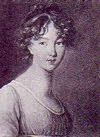Another Dutch quilt with alternate squares of reproduction 18th century floral chintz and indigo block prints, creating the effect of tiles. The fabric is all from Den Haan & Wagenmakers in the Netherlands.*
The backing is a red solid. By the time I made this quilt, I
had gained access to more research about Dutch quilts and had learned that the red
backing was quite common.
The quilt is entirely hand pieced and hand quilted. It is
48” square with each interior square measuring 5 ½” and 7 3/4" across. The quilt has a knife edge border.




6 comments:
I agree, nice shoes and I also love the knitting bag. I can imagine how many wonderful items were made between takeson the sets of those classic movies!
One advantage to red quilt backings is that red dyes tend to be far more light-fugitive -- if it's on the underside of the quilt it stays nicer longer. :->
Also, at least in the US in the early 1800s, red flannel was widely available and relatively cheap (compared to a lot of other colors), and flannel makes a snuggly quilt-bottom.
The quilt is beautiful! I love that blue! How do you hand quilt it? Are you using any period techniques or have any tips? I am hand quilting a quilt right now and am interested in the techniques and how to of hand quilting especially if there are any period techniques!
Good point about the projects behind the scenes. A good topic for a blog post, too - I might borrow your idea!
Thank you for the compliment about the quilt. I do not quit on a frame which, I suppose, would be the closest way to an historic method. Quilts could have been quilted, too, without a frame or any device to hold them taut, of course, then as now.
I use a large round wooden quilting hoop. I have hoops in several widths but I rather think that they are a 20th century invention for quilts. I have not found an historic image of or reference to quilting using a hoop in the 19th or earlier centuries. People also still use frames although there are all sorts of less labour intensive versions available now.
I must admit that I discovered the rotary cutter around the time of making my tenth quilt, and I have cut out my pieces with it ever since.
The only real historical technique or style which is different from most modern quilts is the knife edge I use for most of my reproduction quilts. It is also quick and easy.
Regarding more tips about period techniques. They go hand in hand with the most crucial elements which are, of course, choosing accurate reproduction fabrics from reliable sources, using authentic quilting designs (easily found in books of historic quilts or studying extant quilts) and using batting that resembles the filling of the period of the quilt that you are reproducing/copying, etc. A lot of old quilts that I have examined have filling/batting/wadding that has shifted and left the quilt completely flat with just two layers of fabric in spots. I don't mangle my batting/wadding/filling to mimic that or have cotton seeds or wool fibres coming though but prefer to use a nice flat product like the needled Warm and Natural.
Post a Comment